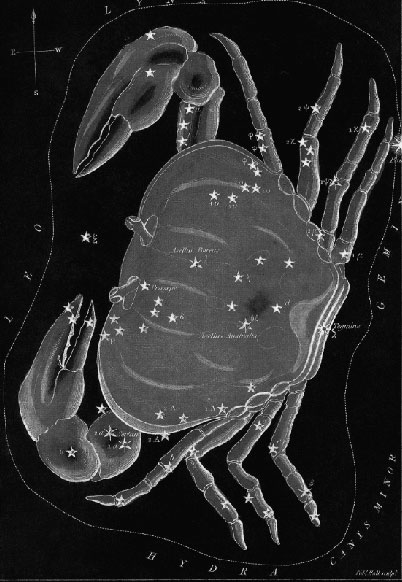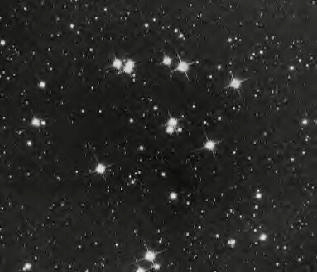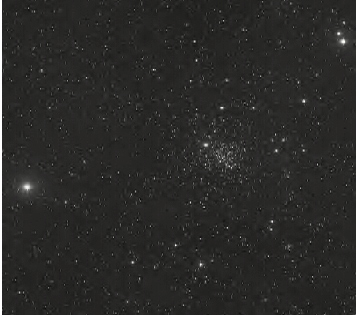
Constellation of the Month: Cancer: The Crab.
by Mark S Deprest
Printed in Reflections: March, 2001.

Cancer,
the crab seems to have been put into the sky to help fill in the 12 signs
of the Zodiac and to sort of tie these 12 signs to the story of the 12
labors of Hercules. The Crab played a bit part in the second labor.
Where
Hercules is to kill the Hydra, a multi-headed, giant water serpent. The
Hydra lived in the marshes Lerna in Greece. Now there are a number
of different
versions to just how Hercules finally managed to overcome the Hydra, which
seem to have a rather unique ability to grow two heads back each time our
hero would lop off one. Hercules finally figured out that if he put fire
to the wound it would sear and seal it shut, so that new heads could not
grow up through the old wound. The Hydra was also renowned to have
an extreme
case of halitosis (breath that could kill), possibly caused by all that
Greek food and the absence of dental floss. While the battle raged, Juno
sent a large crab to attach Hercules’ flank, possibly the first recorded
case of a woman getting one of her friends to pinch the cute guy’s butt.
Hercules quickly disposed of the crab and cut off one its claws which he
then used to kill the last remaining head. Hercules dipped the tips if
his arrows into the festering wounds and coated them with the Hydra’s deadly
juices, so that even the smallest scratch from one of his arrows would
result in death.
Transit at Midnight of Alpha Cancer: February 13th
The
constellation is situated from 6 degrees North to 33 degrees North declination
and is bordered on the East by Leo at 9 hours and 22 minutes Right Ascension,
and to the west by Gemini and Canis Minor at 8 hours Right Ascension.
Most
of the stars that make up Cancer are rather faint to the naked eye. Alpha
Cancri; Acubens is a 4.26 magnitude A3 spectral class star. Beta Cancri;
Altarf is a 3.52 mag. K2 spec. star. Delta Cancri; Asellus
Australis is
a K0 spectral class star that shines at 3.93 magnitude and Gamma Cancri;
Asellus Borealis shines at a meager 4.67 magnitude. Zeta Cancri; Tegmen
is a very nice triple star system where Zeta A is a 4.67 magnitude G0 class
star.
Things to Check Out in Cancer:
Multiple Star Systems
Zeta Cancri; STF1196; ADS 6650
- RA (J2000): 08h 12’12.71” declination: +17d 38’53.3”
- Included
in the Astronomical League’s certificate list of 100 double stars.
Included
in the Saguaro Astronomy Club’s list of 110 best multiple stars. Visual
binary star. Included in Michael R. Feltz’s list of the widest
visual binaries.
- Orbital elements and diagram available on Richard
Dibon-Smith’s
website: (http://www.dibonsmith.com/).
- Component A: magnitude +5.6 spectral
type F8V
- Component B: magnitude +5.9 spectral type F9V
- Component C: magnitude
+6.0 spectral type G5V
- Separation AB: 0.8” at position angle 83
- Separation
AC: 5.9” at position angle 73
- Discovered by Mayer in 1756. Thought to be
a double star until 1781, when Herschel discovered the third component.
The three stars are sometimes said to be yellow, orange and white, although
the spectral classes do not really bear this out. Muirden (1988)
adds that
the unsplit AB appears golden yellow.
- Distance: 83 light-years
- Projected
orbital separation: 15 AU between A and B; 150 AU between AB and C
- Luminosity
(Sun =1): A 3 B 2.1 C 1.7
- Diameter (Sun =1): A 1.5 B 1.3 C 1.4
Iota Cancri;
STF1268; ADS 6988
- RA (J2000): 08h 46’41.83” declination: +28d 45’36.0”
- Included
in the Astronomical League’s certificate list of 100 double stars.
Included
in the Saguaro Astronomy Club’s list of 110 best multiple stars.
Components
show no relative motion. Components display common proper motion.
Colorful
double star.
- Component A: magnitude +4.2 spectral type G8III
- Component
B: magnitude +6.6 spectral type A3V
- Separation AB: 30” at position angle
301
- The color contrast is usually described as yellow (or orange) and blue.
- Distance:
300 light-years
- Projected orbital separation: 2750 AU
- Luminosity (Sun =1):
A 145 B 16
- Diameter (Sun =1): A 20 B 1.6
Phi 2 Cancri; STF1223; ADS 6815
- RA
(J2000): 08h 26’ 47.08” declination: +26d 56’ 07.7”
- Included in the Saguaro
Astronomy Club’s list of 110 best multiple stars. Components display
common
proper motion.
- Component A: magnitude +7.0 spectral type F0III
- Component
B: magnitude +7.9 spectral type A3V
- Separation AB: 5” at position angle
217
- First observed by Struve in 1822. Star A may be a variable.
Described
by Muirden (1988) as “a fine white pair.”
- Distance: 250 light-years
- Projected
orbital separation: 383 AU
- Luminosity (Sun =1): A 7.6 B 3.3
- Diameter (Sun
=1): A 1.8 B 0.8
Deep Sky Objects
M44; NGC 2632; Beehive Cluster; Praesepe

- Praesepe is latin meaning crib or manger.
- Right ascension: 08h40’00.0” Declination: +19d 58’ 59”
- Magnitude 3.1
- Angular
diameter: 95’
- Distance: 586.8 light-years.
- Brightest
star is 6.0 mag.
- Age
660,000,000 years. Contains over 300 members.
- Galileo was one
of the first
to study this open cluster with optical aid and counted forty stars. Over
one hundred of the stars in this cluster are much brighter than our own
sun. In fact if our sun were place in the center of this cluster it would
be visible only in a telescope at a magnitude of 10.9.
M67; NGC 2682;
open cluster.

- Right ascension: 08h50’24.0” Declination: +11d 48’ 59”
- Magnitude
6.9
- Angular diameter: 29’
- Distance: 2347 light-years
- Brightest
star is 9.0
mag.
- Age 3,900,000,000 years.
- Contains 500 members
- NGC 2682:
remarkable
cluster, very bright, very large, extremely rich in stars, little compressed,
stars 10th to 15th mag.
NGC 2775; Caldwell 48; spiral galaxy
- J2000 RA: 09h10.3’ dec.: +07d 02’
- Magnitude 11.4
- Considerably bright, considerably large, round, very suddenly
much brighter in middle, resolvable.
- Angular size 5’x 4’ with a Position
Angle of 155d.
- Face on view makes this a rather difficult object.
- The supernova
1993Z was found in this galaxy on Sept. 23, 1993 at RA 09h 07.7’
declination
+07d 14’ (epoch B1950), magnitude 13.9.
Variable Stars
R Cancri; Mira-type
- Right ascension: 08h16’ 33.8288” Declination: +11 43’ 34.450”
- Period of 361.6 days.
- Periodic variable with a magnitude range from 6.07 to 11.8. In 2001
it should reach its maximum at the beginning of October.
Credits
All Images on this page were downloaded from the Sloan
Digital Sky Survey.
Encyclopaedia Britannica
This page was selected by Encyclopaedia Britannica as a Britannica iGuide site.

Links
Copyright Info
Copyright © 2015, the University Lowbrow Astronomers. (The University Lowbrow Astronomers are an amateur astronomy club based in Ann Arbor, Michigan).
This page originally appeared in Reflections of the University Lowbrow Astronomers (the club newsletter).
This page revised Tuesday, April 10, 2018 7:08 PM.
This web server is provided by the University of Michigan;
the University of Michigan does not permit profit making activity
on this web server.
Do you have comments about this page or want more information about the club? Contact Us.




